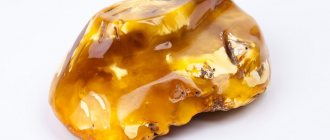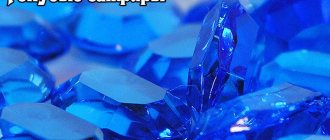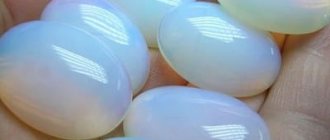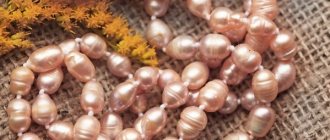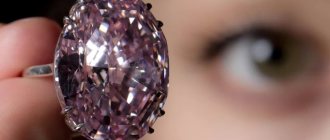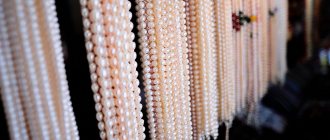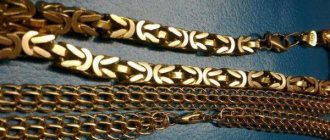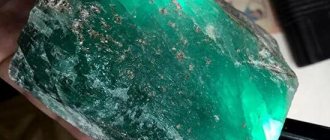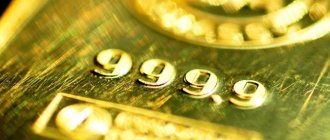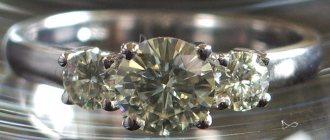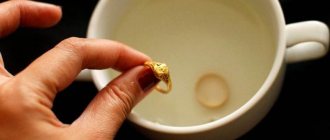Pearl jewelry began to be made in the distant past. Previously, earrings, necklaces and bracelets were in good demand. But even now, you can buy pearl jewelry in specialized stores. However, like any jewelry, it very often becomes an object for counterfeiting. Let's look at all the nuances.
Which pearls are better - sea or river pearls?
Freshwater river is grown in former rice fields in China. Farmers monitor water levels and also turn the pearls over so that they do not turn out “one-sided”. During the growing process, a person controls only the conditions for growth and the shape, but does not “grow” the nacre itself into balls and other materials.
Cultured freshwater pearls look brighter than sea pearls because they have a thicker layer of nacre. This phenomenon is associated with the introduced seed nucleus into mollusks.
Its colors, sizes and shapes are varied. In this regard, it is popular and in demand.
Freshwater is cheaper than seawater. During the cultivation process, 20-30 pearls can fit into its shell, but usually only one into a sea shell.
Akoya pearls are a "classic". Jewelry made from it is often found in jewelry stores. Most of it is grown and collected in Japan on the islands of Honshu and Kyushu, Ago Bay. It is also grown in Vietnam and China.
Akoya pearls are spherical in shape and have a diameter of 2-10 mm. In color it can be cream, silver, pink, pale yellow, with a green-black tint.
Assortment offered by the market
The romantic halo of pearls makes them the object of desire for many. However, in natural conditions it grows slowly, is difficult to obtain, and costs prohibitively. People have learned to grow beautiful balls on their own. Therefore, it is worth distinguishing between natural and cultivated material. The most affordable price segment is made from polymers. We wrote more about the types, properties and who is suitable for pearls here.
Natural
There are two types of pearls in nature: sea and river. The former are five to six times more expensive than the latter. This is not surprising - to find one high-quality pearl, you need to pull half a ton of mollusks out of the water. Freshwater river material is easier to obtain; its distinguishing features are not always an ideal shape and a weak shine.
Sea pearls of impeccable shape and shine are more often found at auctions than in stores.
Cultured
It is not considered a fake, although it is created by people. The technology is as follows. On a sea or river farm, a core base is placed inside the mollusk. Maturation takes place under natural conditions. After two or three years, a pearl is obtained that is visually indistinguishable from a natural one, but of a certain shape and color. That is, the mother-of-pearl layer is real. The difference is inside: in cultivated specimens it grows around an artificial core.
The thickness of the mother-of-pearl coating depends on the period of creation of the pearl.
High-quality specimens are supplied from farms along the Indian Ocean coast. The world leader is Japan, followed by China, Hong Kong, and the Emirates.
Therefore, when purchasing cultured pearls, find out the country of origin.
Artificial
A product of modern technology. Fake pearls come in several varieties.
Majorca
The production process is multi-stage, so the imitation is very high quality. Only an expert knows how to check the authenticity of pearls in this case. Named after the place of creation in the Spanish city.
Roman
Hollow glass beads with paraffin inside. The method was invented in the Middle Ages, initially it was rough work. Later, pearl essence from fish scales was used for coating, which visually ennobled such artificial pearls.
Shell pearl
Mother of pearl cores coated with varnish. Received in the 1920s. in USA.
Plastic
Frankly low quality products. Sold in jewelry departments.
Determining the authenticity of pearls in a store
Method number 1. Cost of real beads
Pay attention to the price. Only costume jewelry is sold at a low cost. But a high price is also not always an indicator of the authenticity of pearls.
Beads made from the least valuable white gems of irregular shape will cost several thousand rubles. For cultured round stones with a diameter of 15 mm you will have to pay from 2 thousand dollars.
The price is affected by the color, diameter, origin, and shine of the pearl.
The cost also depends on the quality of the surface. Therefore, the price varies greatly. On sale, products with natural pearls cost from $15 to $100,000. At auctions, some pearls sell for millions of evergreens.
Method number 2. How much does a real pearl weigh?
Natural weighs more than artificial. This is due to the fact that inside the real one there is mother of pearl, and the fake one is plastic, artificial stone or other light material. The weight of the pearl in the hand is felt; it cannot be practically “weightless” even if it is small.
Method No. 3. Compare each pearl by shape in a necklace or bracelet
Each pearl has an individual shape. Even if they are all spherical, they still have slight differences from each other and peculiar defects, no matter how carefully they were selected by professionals during the assembly of the jewelry.
Care
Like any natural stone, artificial pearls also need timely care. To make your jewelry look decent, you should consider a few recommendations.
- The decoration can only be wiped with a napkin or cloth.
- Do not put it in water or try to clean it by placing it in a solution with a chemical.
- It is recommended to remove heavy dirt only with a damp cloth.
- You should not try to clean jewelry with artificial pearls using steam or ultrasound.
- Such products must be stored in special bags or in boxes lined with velvet.
- Contact of synthetic pearls with a solution of alcohol, vinegar, bleach, perfume, deodorants and creams is unacceptable.
- It is not advisable to wear jewelry without doing your hair. Artificial stone does not withstand contact with hair styling products.
In the next video you can watch the process of creating artificial pearls.
Determining authenticity at home
Method number 6. Sound test
If you rub a pearl over your teeth, it will make a creaking sound, but a fake one will not.
Mother of pearl has low thermal conductivity, meaning it heats up very slowly. Thanks to this, the beads remain cold for a long time even when they touch human skin. Plastic jewelry heats up quickly from body heat. This is not the most accurate way to distinguish real pearls from fakes, as it is very subjective.
Method No. 7. Fall and hit
If there are individual pearls, and not a piece of jewelry, then you can conduct a test - drop one of them from a height of about 0.5 meters.
The real one bounces off when it hits a horizontal surface like a ball. But the artificial one will just roll.
Method No. 8. Friction
In a necklace, you can rub one mineral against another by applying slight pressure. Small particles of pearl powder and scratches should form. These scratches can be easily removed by rubbing the surface with your fingers.
If the mineral is artificial, then the powder will not appear, and the scratches cannot be removed, since the layer of pearlescent paint will be erased and what will remain is an ordinary bead - an artificial core.
Mother of pearl is a dense substance with low hardness, which is up to 4 Mohs units. Therefore, the gemstone is easy to damage. To do this, just scratch it with a knife.
When exposed to a knife, a thin layer of mother-of-pearl will begin to peel off from the original. It will look like powder. The fake will have chipped paint and expose the artificial core.
After scratching with a knife, you need to wipe the surface with your finger. All damage to real mother-of-pearl will disappear and it will return to its original appearance. On a fake, all scratches and paint chips will remain in place.
Method number 9. Chemical test
Place the pearl in acetone. The real one will not dissolve in acetone, only the artificial one.
Testing with vinegar destroys real pearls. Therefore, you should resort to it only by removing one pebble from the beads.
Plastic fake will not react with vinegar. The advantage of this method is the ability to identify cultured pearls. After the nacre layer dissolves, its core will become visible.
Fake artificial pearls: what they look like
If mollusks take the main part in the creation of cultured pearls, albeit with human assistance, then they have nothing to do with artificial material.
In the modern world, artificial beads are created using different technologies, using both natural mother of pearl and its artificial alternative. What is the difference between artificial pearls and natural pearls? It's easy to notice the differences. Typically, imitation stands out with a brighter color and unnatural shine. There are other ways to identify a fake even at home, but more on them later.
Spanish, Italian, American and French imitations are worthy of attention
Pearls are created from porcelain or alabaster balls and covered with the best mother of pearl in several layers. It is almost impossible to distinguish the finished work from cultured pearls. The beads play amazingly in daylight and have the same natural surface. How to care for such beads? Just like with natural ones - wipe from time to time with a damp soft cloth, do not use alkaline solutions.
- An interesting technology for creating mother-of-pearl beads was invented in France. Pearls in French are blown glass filled with colored paraffin. It is not surprising that as a result it is possible to create beads of different colors, including pink pearls, which are rare in nature. This option only vaguely resembles the real material.
- The Italians were a little more successful. They also take blown glass and paraffin as a basis, but for greater similarity they add mother-of-pearl dust to the material.
- The Americans have gone even further in the technology of creating artificial pearls. They cover mother-of-pearl balls with several layers of a special polymer mixture, achieving maximum identity with the natural prototype.
So how can you tell the difference between genuine pearls, or at least cultured and artificial ones? There are several simple ways. Let's start with the main features of natural beads. Although it is almost impossible to find them on store shelves.
Additional verification methods
Information on the tag
Natural pearls are always accompanied by a quality certificate. You must ask the seller before making a purchase. A quality certificate is an additional guarantee of the natural origin of a precious stone.
Ultraviolet
It is harmless to shine ultraviolet light on pearls. Natural stone gives a bluish glow, while artificial stone gives a green glow. Some fakes do not react to UV rays at all. The source of ultraviolet light can be a special flashlight or a device for checking banknotes.
Fire
Natural pearls are not afraid of fire. It can be brought into the flame for a couple of minutes. In this case, the fake glass will crack, and the plastic jewelry will melt.
We carry out identification
The maximum that can be done at home is to distinguish fake glass. To determine authenticity, jewelers use a special liquid in which a real sapphire is kept afloat while other stones sink, a refractometer, an ultraviolet lamp and a number of other special devices.
A natural crystal is practically no different from a synthetic crystal in color, appearance and physical properties. The only guarantee is the reputation of the seller. The purchased stone (no matter whether it is an independent unit or an element of a product with sapphire) must have a quality certificate indicating whether it is synthetic or a natural product. If the stone is natural, then the certificate indicates whether it has been refined or not.
Nowadays, most stones are refined by annealing or other manipulations. These procedures are aimed at improving their quality. An ennobled crystal is not considered a fake, but a note about this should appear in its “passport”.
Checking the authenticity of a sapphire ring
The refined stone is determined by illumination with ultraviolet irradiation. If it has been annealed, it will give a greenish glow in ultraviolet light. Natural sapphire glows white under a lamp.
The main methods of differentiation are aimed at distinguishing blue corundum from glass or other crystals.
- Look the stone up to the light. Sapphire slightly changes its hue when illuminated, when it is turned first on one side or the other to the light stream. This is the phenomenon of dichroism.
- Crystal differs from glass in its increased hardness and sharp, clear edges.
- Tanzanite can be suspected by its reddish tint.
- Kyanite - by the presence of longitudinal stripes.
- Spinel is dark and cloudy compared to sapphire. It is issued only for sapphires of low-value varieties.
Arm yourself with a magnifying glass with tenfold magnification. The structure of the sapphire does not imply the presence of gas bubbles, but inclusions of other materials that were adjacent to it in the rock are very likely. An artificial crystal, which was created as an independent decoration, will not have inclusions. But this method will not help to identify a fake, which was made with the aim of copying natural corundum as accurately as possible. Adding foreign substances in powder form is not difficult for black market chemists.
To determine artificially grown stone, liquid monobromonaphthalene is also used. The sample is placed in this liquid, the vessel is placed on a white background and illuminated from the side. In natural stone, “growth lines” are visible - straight veins. In synthetic ones they are curved.
Checking the authenticity of a sapphire
There are gas bubbles - this is a fake, and of low quality.
Also, using a magnifying glass, you can identify a doublet or triplet - gluing together several plates of blue stone. The sapphire plate is located on top or in the center, other structural elements are glass or cheaper minerals. The gluing line is visible under high magnification.
Blue tourmaline can only be detected using a refractometer - its refractive indices differ, and only slightly. For control, a special liquid is used that holds the sapphire on the surface, but other stones sink in it.
It is impossible to distinguish tourmaline from sapphire at home.
The rays of the star consist of inclusions of rutile. If you turn the stone, the location of the real star will visually change, it will “move”. In a fake, the three-rayed star is always visually located in one place; the “shift” effect from changing the viewing angle in imitations is currently impossible to replicate.
Keshi – mother-of-pearl “grains”
This is what keshi is called “grains” in Japanese. Small shimmering organic pebbles appear in the bodies of freshwater and sea oysters as “side effects.” The beads were first discovered in a shell after a failed grafting. Despite the fact that the oyster was unable to establish the process of enveloping the main core with nacre, the process was launched for small particles that naturally penetrated inside the pearl sac.
Such pearls are not specially cultivated, despite the fact that they are quite expensive, although they are inferior in price to larger “loose” beads. No one can predict the shape and size of Keshi pearls. They can be either flattened, resembling flower petals, or round or of any irregular shape.
"Wild"
Of course, in the fight between natural pearls and artificial pearls, the first will win. Unfortunately, it is almost impossible to find on the modern jewelry market. In the natural environment, as is known, a pearl is formed after a foreign body, for example, a small parasite or a grain of sand, enters the body of a mollusk. It takes years to form a stone. It is quite rare to find round pearls in their natural form.
Abalone is a rare species
Among all the varieties, abalone is the least common. The mother-of-pearl formation matures in a single-vave oyster called abalone, that is, abalone. The oyster differs from its fellows in its non-standard anatomical structure, which makes the introduction of an implant into it almost impossible.
Pearls are mined on the coast of the American state of California and near Mexico. In exceptional cases, samples of abalone pearls are found in Japan, Australia, Thailand, New Zealand and even Korea.
Abalone is one of the oldest species of marine organisms. It is believed that it has lived on the planet for more than 30 million years. The pearls formed inside its shell are distinguished by absolutely incredible shades and tints of a mixture of colors.
Jewelers highly value abalone and the brighter the surface, the more you will have to pay for it. The shape of the pearl is also unusual. This is a rarely familiar area. Mostly the formations are oblong. For one abalone pearl up to 4 mm in diameter you will have to pay more than $300, and this is without a frame.
Rub the beads together
This verification option is suitable for a bracelet, earrings or pearl beads. It is necessary to have several samples of pearls that can be rubbed against each other. At the moment of contact, if the material is genuine, you will feel an increasing force of friction. This is again due to the imperfect top layer. Fake mother-of-pearl beads will begin to slide when rubbed and produce an unpleasant artificial sound.
At the end of the test, look at your fingers in daylight. After contact with natural pearls, a little pearlescent dust remains on the skin.
Important to consider
Imitation production technologies are actively developing, and identifying fake pearls is becoming more and more difficult.
The more methods you use when checking, the more signs of authenticity or imitation you will find.
None of the proposed methods, or even their combined use, provides a 100% guarantee of identifying a counterfeit. If you want to get an accurate result, contact a professional jeweler or gemologist. It is very important to take advice from experts in the world of pearls.
Natural pearls have many advantages. Only natural specimens are valued in lithotherapy or can serve as a profitable investment. Therefore, it is important to be able to distinguish natural pearls from artificial ones.
Vinegar vapor poisoning symptoms
Acetic acid poisoning poses a threat to human life. The victim must be assisted immediately to avoid dangerous consequences. Vinegar intoxication has clear clinical symptoms, which prevents it from being confused with poisoning of another nature.
Acetic acid is a clear, colorless liquid with a specific odor. It is used both for industrial purposes (for example, in the manufacture of medicines) and in everyday life as table vinegar.
Conch - a gift from the Caribbean
The Caribbean Sea is home to a special type of single-vave conch oyster. Another variety of natural pearls is named after them. The peculiarity of mollusks is their vulnerability. They cannot be opened without killing them. This fact saved the lives of individuals and the entire population.
Defenseless and small, the organisms continue to live at the bottom of the Caribbean Sea and are not subject to mass extermination. It is prohibited to obtain pearls by killing shellfish, and cultivating them is unprofitable. Nevertheless, rare finds extracted specifically from the shells of conch mollusks “leak” onto the market. Their price is impressively high, despite the fact that the surface is not cast with mother-of-pearl.
Overall, the beads look amazing: an unusual surface similar to frozen silk, an almost flawless shape, available in a wide variety of colors, ranging from lilac to olive and violet specimens.
